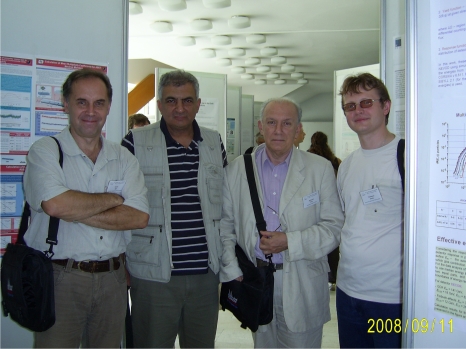
| 2008-09-12 11:10:56 |
|
Participation of the CRD delegation in European Cosmic Ray Symposium
The 21st ECRS - European Cosmic Ray Symposium was held at the Technical University of Košice, Košice, Slovakia, from Tuesday 9th September to Friday 12th September 2008.
The scientific program included oral and poster presentations covering the following topics:
1. Relationship of cosmic rays to the evironment.
2. Energetic particles and the magnetosphere of the Earth.
3. Energetic particles in the heliosphere.
4. Solar-terrestrial effects on different time scales.
5. Cosmic rays below the knee.
6. Cosmic rays above the knee.
7. High energy interactions.
8. GeV and TeV gamma ray astronomy.
9. European projects related to cosmic rays.
Approximately 150 scientists from 20 European countries delivered 76 oral and 120 poster presentations. The interest of symposium has considerably changed from research of high energy galactic cosmic rays (knee- region physics, muons, strong interactions) to the solar terrestrial connections and solar physics and space weather.
The Armenian delegation (A.Chilingarian and G.Hovsepyan) presented 3 oral and 2 poster presentations:
A.Chilingarian; Surface Particle Detectors in Space Weather forecast;Research of the Galactic Cosmic Rays from knee till cutoff (10^16-10^19) eV at Aragats Cosmic Ray Observatory;
G. Hovsepyan; Size and Energy Spectra of incident cosmic radiation obtained by the MAKET ANI surface array on mountain Aragats.
Poster presentations:
Hybrid particle-detector network located at Middle-Low latitudes for Solar Physics and Space Weather researchP2.12A; Parameters of the Aragats Space-environmental Center monitors as measured at start of 24-th Solar Cycle.
The International board of symposium was decided to be held in Turku, Finland in 2010.
As usual, during the symposium the Armenian delegation participated in the European projects meetings:At the INTAS 8777 project meeting Armenian delegation reported on the new electronics to be commissioned for the large Aragats Multichannel Muon Monitor (AMMM) and calculations of the most probable primary proton energies for the Aragats particle detectors. The next project meeting will be held in Izrael in February-March just before closing the project. The draft of the final project should be prepared bythe end of 2008.
After the conference, one day meeting of the “Real-Time database for high resolution Neutron Monitor measurements” (NMDB - Grant Agreement Number 213007 was held at the Kosice technical university.
After listening to all package leaders and discussing current status of project it was decided to make some important changes and rearrange some project tasks. The next ext meeting was planned at Kiel, Germany on 3-5 December, 2008.
The Armenian delegation proposed to include in the meeting scientific session with 2 topics:
Filtering algorithms for time series smoothing;
Space Weather alerts based on NM data.
Meeting with the Bulgarian and Croatian delegation on the installation of SEVAN particle detectors were also held. The both groups have already prepared the PM and scintillator housings. The Armenian experts will finalize the detector assembly in late Autumn or Winter of 2008.

Figure 1Gagik Hovsepyan reprting MAKET-ANI final results

Figure 2 At poster session. From left to right: I.Yashin, (MePhI, Moscow, Russia), A.Chilingarian (YerPhI, Armenia), P.Spillantini (scientific attaché of Italian Embassy in Moscow), D.Timashkov(MePhI, Moscow, Russia – declared the best young scientist of the symposium).

Figure 3 INTAS collaboration meeting. From left to right: R.Butigover, E.Fluckiger (both Bern university, Swiss), A.Chilingarian (YerPhI, Armenia) and project coordinator R.Hippler (Greifswald univ., Germany).

Figure 4 A.Chilingarian and the chair of the European symposiums board sir Arnold Wolfendale discussing the fine structure of the “knee”.

Figure 5 Prof J.Stamenov (director of Institute of Nuclear Physics of Bulgarian Academy of science) explains the SEVAN detector status in Bulgaria.

Figure 6 NMDB meeting. From left to rigjt: G.Hovsepyan (YerPhI, Armenia), E.Vashenyk (Polar Institute, Apatiti, Russia, R.Butigover, E.Fluckiger (both Bern university, Swiss), A.Chilingarian (YerPhI, Armenia)
